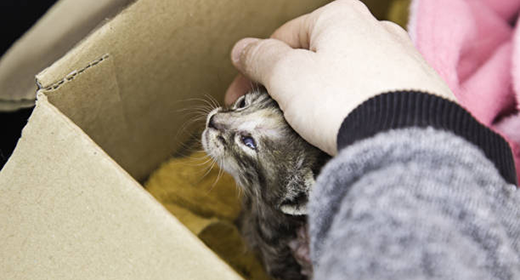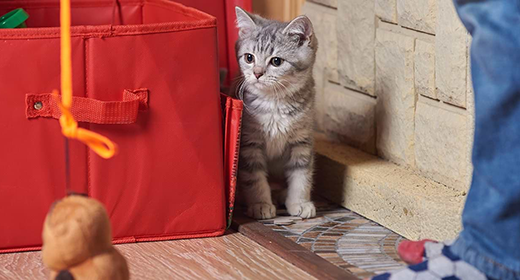

Providing your kitten with the proper nutrition goes way beyond just putting fresh food in a clean bowl. Your kitten’s nutritional needs will change as their body develops through adolescence and into adulthood. Proper nutrition during these critical growth periods will help your kitten mature into a strong, healthy adult cat.
The nutritional needs of kittens and cats are vastly different, and it’s critical to give your pet premium age-appropriate nutrition. Here’s everything you need to know about kitten food vs. cat food and how to feed your growing kitten.
After kittens are weaned, they enter a stage of rapid growth, which lasts until they’re 6 months old. They need a high-quality, balanced diet with every bite packed with the nutrients and energy needed to sustain such rapid development. The best choice is a premium kitten food with animal-based proteins. It should be highly digestible, nutrient-dense and designed to meet kittens’ unique nutritional needs, such as IAMS™ PROACTIVE HEALTH™ Mother And Kitten.
Kittens require twice as much energy as adult cats on a per-pound basis. But their smaller mouths, teeth and stomachs limit the amount of food they can digest during a single meal. It’s best to divide the total daily food amount recommended on the kitten food packaging into three or four smaller meals.
As kittens approach adult size, their nutritional requirements begin to change again. Their rate of growth begins to slow, activity levels may decline and they can start eating fewer, larger meals each day. During this stage, kittens begin to look like adults, but they are still growing and need the special nutrition found in kitten food.
During the adolescent growth stage, many cat owners are tempted to change a kitten’s food for variety. But cats do not get bored with a consistent diet of high-quality dry food, and giving a kitten “human food” and table scraps can lead to undesirable behaviors, such as begging or stealing food.
Additionally, feeding homemade diets, food formulated for adult cats or supplementing an already complete and balanced diet with vitamins could cause nutritional disorders.
At about 12 months of age, your kitten will reach their full adult size. Your young adult cat no longer needs calorie-dense kitten food to fuel growth and is ready for a diet of adult cat food.
When your cat is about 12 months old, it’s time to switch to a maintenance formula adult cat food, such as IAMS™ ProActive Health™ Healthy Adult. At this age, cats no longer need the extra calories and nutrients found in kitten food. As with any change in a cat’s diet, remember to gradually transition from kitten food to adult food over a period of several days.
To avoid intestinal upsets, make the change from a kitten formula to an adult diet over a period of four days with the following method:
Because cats generally eat only what they need, free-choice feeding is fine for most cats. (With free-choice feeding, you can provide food to your cat around the clock and let them eat when and how much they need.) Indoor cats that don’t get much exercise, however, may overeat if fed free-choice. For them, portion-controlled feeding twice a day is a better routine.
To determine how much food to give your cat, check the recommendations of the pet food manufacturer on the label. Use the guidelines, monitor your cat’s weight and body condition during the transition, and adjust feeding portions if necessary. If your cat is gaining or losing weight and shouldn’t be, slightly adjust their daily intake and weigh them again the following week.
Make sure to choose an adult cat food that provides the same high-quality nutrition as a premium kitten food. Downgrading to a basic nutrition brand at this stage of your cat’s life may upset their digestive system and won’t provide them with the same type of nutrition they were raised on. Premium foods like IAMS™ are formulated to meet all of your cat’s needs and provide additional benefits. They’re specifically designed to provide your cat with a formula that features:
All of these premium features add up to a happy, healthy cat. With premium dry cat food, you can expect to see these important indicators of good health:
Founded on decades of research, premium formulas from IAMS™ help maintain your cat’s health and help provide her with the nutrition she needs for a long life.


Understanding and learning how to decipher kitten food product codes will help you choose the right kitten food. While selecting the right ingredients is important, making sure those ingredients are fresh is just as vital to your young cat. Learn how to read the product codes of kitten food packages and cans with our handy guide.
A product code is a series of numbers and letters printed on the outer package of each product a manufacturer produces. This code provides information about when and where the kitten food was made.
As part of the product code, IAMS™ products include a “Best Used By” date, or the date at which the product is no longer considered fresh and should no longer be sold. This date is expressed in “ddmmyy” and “ddmmmyy” formats.
The second line of the product code represents company internal information for use in traceability and inventory control.
Line 1: (ddmmyy) (ddmmmyy)
Example: 040220 04FEB20
Line 2: 60351111## QQQQQQQ
This product should be used before February 4, 2020.
Depending on the production line, pouch products* may have code date information in a single or double line. By recognizing and understanding these codes, customers can make sure they are receiving a fresh product.
Shelf life is the duration, measured in months, during which a properly stored kitten food product maintains its freshness. This means if a product has a 16-month shelf life, it is fresh for up to 16 months from the date of manufacture.
The shelf life for IAMS dry kitten foods is 16 months. All canned formulas have a shelf life of 24 months.
Unopened dry kitten food products are best stored off the floor in a cool, dry place. Open bags of kitten food should be stored in a clean, dry container with a tight seal. Dry kitten food products may also be frozen without loss of nutrients.
Opened wet kitten food products are best kept refrigerated in tightly sealed containers for no more than three days after the container has been opened. Wet products should not be frozen in unopened cans. However, wet kitten foods can be frozen if removed from the container, packed in freezer containers and frozen immediately.
*IAMS has no kitten pouch products at this time.